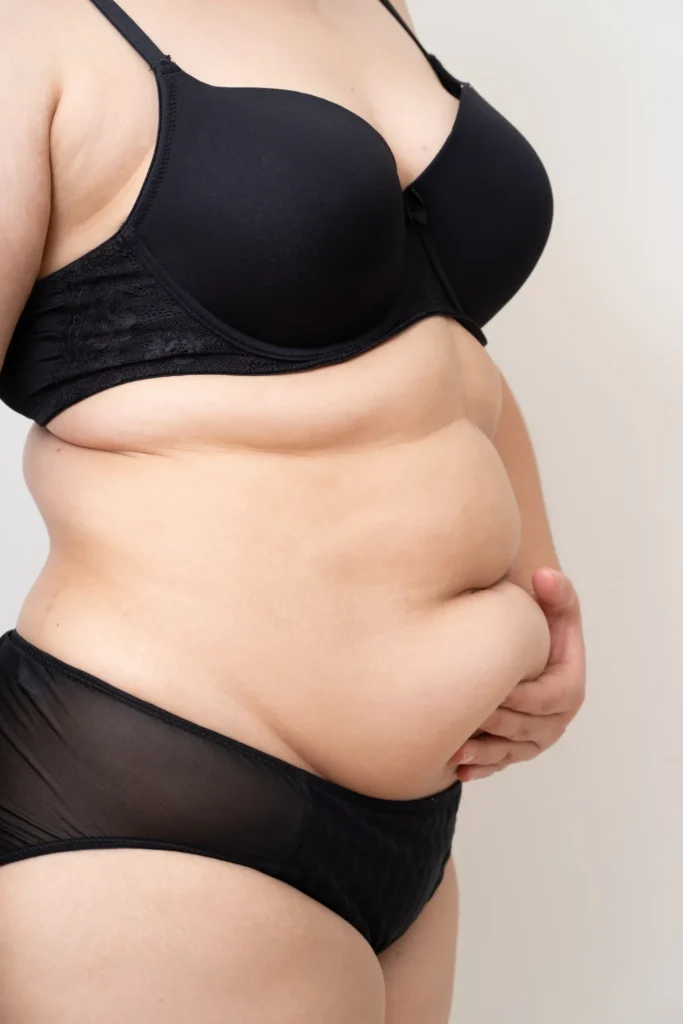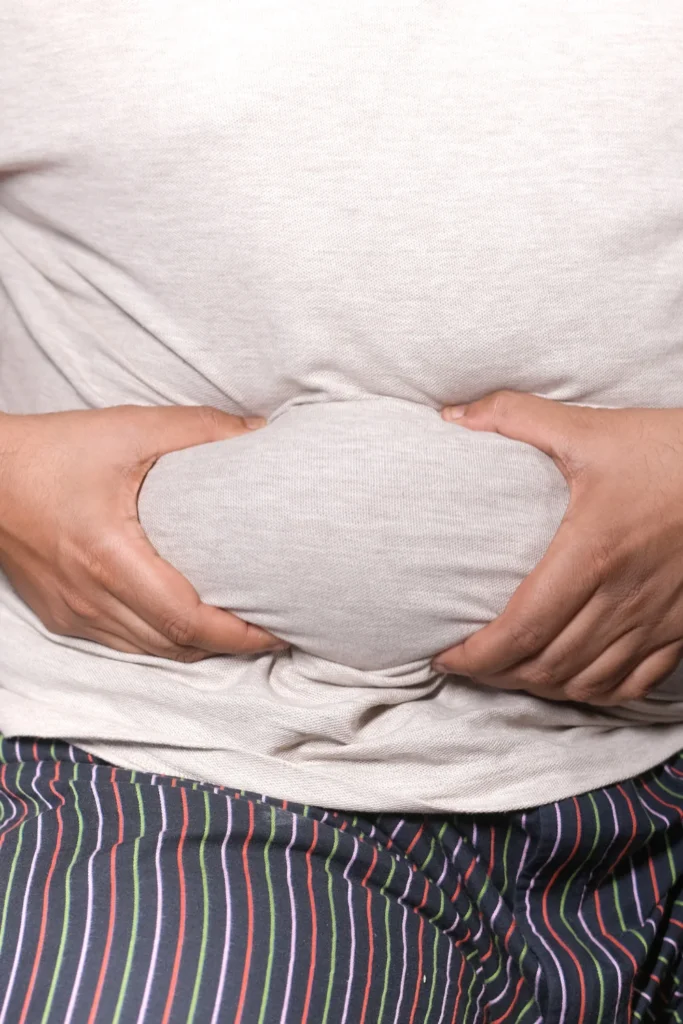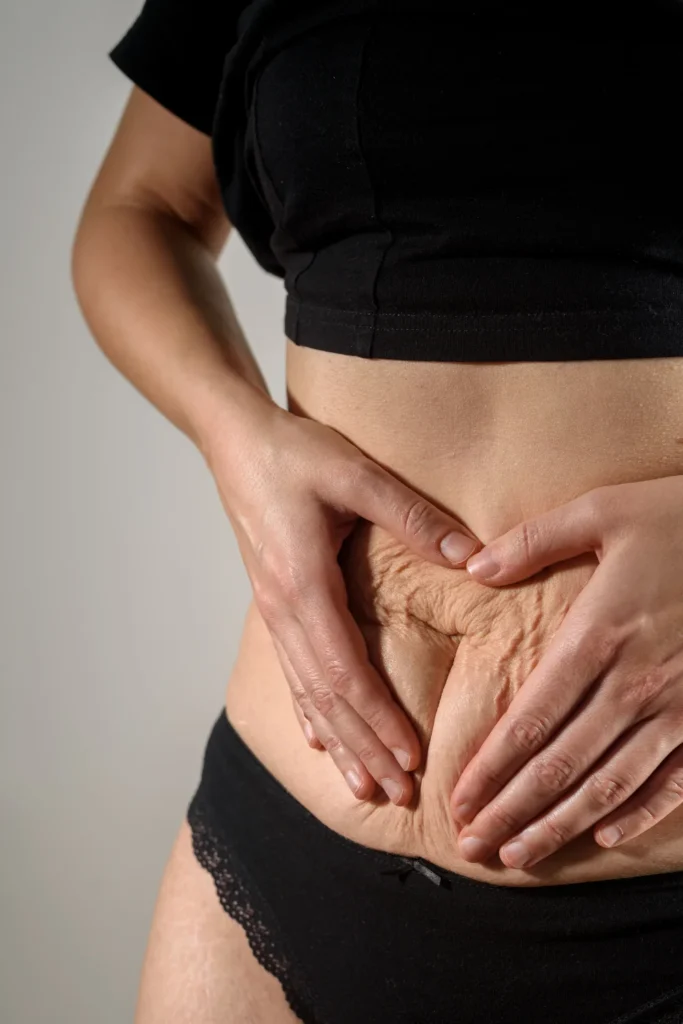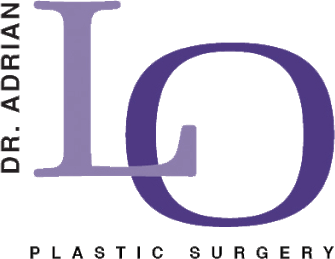
You are celebrating a happy event – your weight loss! This weight loss may have occurred due to many reasons, from losing your pregnancy weight to diet and exercise to weight loss medications such as GLP-1s. However, there may be an unforeseen by-product of your weight loss that may be holding you back from feeling that you have achieved your goals. Significant weight loss can result in excess skin hanging from your abdomen. While it is a result of your weight-loss success, it may also be the cause of some new struggles.
Abdominal pannus resection offers a proven solution that removes excess skin from weight loss, restoring your mobility, eliminating chronic health problems, and giving you back the freedom to live without physical limitations from the excess skin.
Thousands of patients have transformed their lives through this surgery.
Understanding what is abdominal pannus resection (also called a panniculectomy) surgery and how it differs from a tummy tuck (also called abdominoplasty) can help you take the first steps towards understanding your options on what you can do to achieve the final look that you desire after your weight loss.
Related: What Makes a Men Tummy Tuck Different?
Definition of Panniculectomy
Panniculectomy removes excess skin and fat from your lower abdomen. The surgery specifically targets the pannus – the apron of skin that hangs down from your belly. Most patients develop this condition after major weight loss or multiple pregnancies.
The procedure serves a functional purpose and a cosmetic one. Your plastic surgeon addresses health issues caused by excess abdominal skin.
These problems may include chronic rashes, recurring infections, and possible severe mobility restrictions that impact your daily life.
During surgery, your plastic surgeon makes an incision across your lower abdomen to remove the overhanging tissue.
The remaining skin gets repositioned and sutured to create a flatter, more functional abdominal contour. This abdominal surgery for excess skin focuses primarily on restoring function rather than appearance alone.
Differences Between Panniculectomy and Abdominoplasty
Panniculectomy vs. abdominoplasty represents two distinct surgical approaches with different goals and techniques.
Understanding these differences helps you choose the right procedure for your specific needs and health concerns.
Panniculectomy removes excess skin and fat for functional improvement only. Your plastic surgeon does not repair muscles or perform extensive liposuction contouring during this procedure. The primary goal involves eliminating the hanging pannus that causes health problems and mobility limitations.
An abdominoplasty or tummy tuck combines skin removal with muscle repair and aesthetic enhancement. This comprehensive procedure addresses both functional and cosmetic concerns simultaneously. Your plastic surgeon creates a more sculpted abdominal appearance while tightening weakened or separated muscles.
Your specific anatomy, health concerns, and desired outcomes determine which procedure works best. A plastic surgeon evaluates your individual situation to recommend the most appropriate surgical approach for your needs.
Reasons for Undergoing Pannus Resection
Patients seek pannus resection for mainly functional reasons rather than purely cosmetic goals. The hanging abdominal skin creates numerous health challenges that significantly impact daily life and overall well-being.
Chronic skin irritation develops frequently under the pannus due to trapped moisture and constant friction. These conditions become persistent and difficult to manage with conservative treatments alone. The environment created by rubbing and moisture allows bacteria and fungi to thrive, leading to recurring infections.
Mobility limitations represent another major concern for patients with excess abdominal skin. The weight and bulk of the pannus may interfere with walking, exercise, and normal daily activities.
Many patients discover that clothing does not fit properly, and maintaining personal hygiene becomes increasingly challenging over time.
Weight loss and pannus resection are directly related as many patients develop excess skin after significant weight reduction. While weight loss provides numerous health benefits, the remaining skin can prevent patients from fully enjoying their improved health status and enhanced mobility potential.
The Surgical Procedure Explained

Overview of the Pannus Resection Process
Surgical planning begins with careful marking while you stand upright. This positioning ensures optimal results and helps your plastic surgeon determine the amount of tissue requiring removal.
The procedure typically requires between two and three hours, depending on the extent of tissue removal needed for your specific case.
Your plastic surgeon makes a horizontal incision across your lower abdomen during surgery. The incision placement is hidden by your underwear after healing occurs.
Excess skin and fat are carefully separated from the underlying muscle and removed as a single unit. The remaining skin then gets repositioned and secured with multiple layers of sutures.
Surgical technique focuses on creating smooth, natural-looking contours while prioritizing functional improvement. Special attention goes toward preserving the blood supply and ensuring proper healing of the surgical incision site.
Anesthesia Options: Local vs. General
Most pannus resection procedures use general anesthesia to ensure patient comfort and safety throughout the operation.
General anesthesia allows your plastic surgeon to work efficiently while you remain completely unconscious and pain-free during the entire procedure.
Smaller tissue removal cases may allow local anesthesia with sedation as an appropriate alternative. This option typically applies to less extensive procedures where the pannus remains relatively small and surgery can be completed quickly and safely.
Several factors influence anesthesia choice, including:
- The extent of skin and fat removal required
- Your overall health status and medical history
- Personal preferences and anxiety levels
- Previous experiences with anesthesia
Surgical Techniques Used in Pannus Resection
Modern surgical techniques optimize your functional result while minimizing complication risks. Your plastic surgeon employs careful tissue handling and surgical methods to ensure optimal healing and long-lasting results.
Layered closure techniques reduce tension on the incision and promote superior healing outcomes.
Your plastic surgeon typically places deep sutures to support the closure, followed by skin sutures or medical adhesives to complete the repair process.
Advanced surgical planning includes careful attention to incision placement and tissue removal patterns. These refined techniques help ensure that your final result provides maximum functional benefit while minimizing visible scarring in the treated area.
Recovery Process After Pannus Resection

Immediate Post-Operative Care
The first 24 to 48 hours after surgery require close monitoring and specific post-op care protocols for optimal healing.
Surgical drains are placed to prevent fluid accumulation and to promote proper tissue healing. These drains typically remain in place for one to two weeks, depending on your individual healing progress and drainage output.
Compression garments play an important role in your immediate recovery period. These specially designed garments help reduce swelling, support healing tissues, and provide comfort during the initial recovery phase.
You must wear these garments continuously for 4 to 8 weeks following surgery to achieve the best possible outcomes.
Activity restrictions during the immediate postoperative period ensure proper healing and prevent complications. You need to avoid lifting, bending, and strenuous activities while your body begins the healing process. Walking is encouraged early after surgery to promote circulation and prevent blood clots in your legs.
Pain Management Strategies
Effective pain management ensures a more comfortable recovery experience for every patient.
Your plastic surgeon prescribes appropriate pain medications to keep you comfortable during the first few days after surgery. Over the counter pain medications are often used to provide relief and comfort. Non narcotic pain pumps can help with pain control for up to 72 hours after surgery. Proper positioning and support pillows also help minimize discomfort during rest periods.
Most patients experience significant pain reduction within the first week after surgery. By the second week, many patients can manage their discomfort with over-the-counter pain relievers rather than prescription medications.
Expected Recovery Timeline
Recovery time for pannus resection varies depending on the severity of the abdominal pannus and individual healing factors.
Most patients can return to light desk work within one to two weeks after surgery, provided they avoid heavy lifting and strenuous activities.
Physical activity restrictions typically last four to six weeks following your surgical procedure. During this period, you will gradually increase your activity level under your plastic surgeon’s careful guidance and supervision.
Light walking is encouraged from the beginning, with more vigorous exercise introduced gradually over time.
Complete healing and final results may require several months to fully achieve. Your surgical incision continues to improve in appearance for up to a year after surgery, with most significant healing occurring within the first three months post-operatively.
Benefits of Pannus Resection

Improving Mobility and Comfort
One of the most significant benefits of abdominal pannus removal involves immediate improvement in mobility and physical comfort levels.
Patients consistently report feeling lighter and more agile after recovering from surgery.
Simple activities like walking, climbing stairs, and getting in and out of chairs become much easier to perform.
Removing excess weight from your abdomen can also reduce chronic back pain and improve overall posture. Many patients discover they can participate in physical activities they had avoided for years due to the bulk and weight of their pannus.
Clothing fit improves dramatically after pannus resection surgery. Patients can wear properly fitting clothes and may need to purchase a new wardrobe to accommodate their improved body contour and enhanced comfort levels.
Reducing Skin Irritation and Infections
Personal hygiene becomes much easier to maintain after the surgical procedure.
Patients can clean and dry the abdominal area more effectively, preventing the buildup of moisture and bacteria that contribute to ongoing skin problems and infections.
Chronic skin problems often resolve completely after pannus resection surgery. Removing overlapping skin eliminates the warm, moist environment where harmful bacteria and fungi thrive naturally. This elimination leads to a significant reduction in skin infections and chronic irritation problems.
Eliminating chronic skin issues often leads to improved confidence and reduced anxiety about odor and appearance concerns.
Many patients report feeling more comfortable in social situations after their complete recovery period ends.
Impact on Daily Activities and Quality of Life
Daily activities become significantly easier after pannus resection surgery. Tasks like bathing, dressing, and personal care no longer present major challenges or cause discomfort. Many patients report increased energy levels and improved sleep quality following their recovery.
Exercise and physical fitness become more achievable goals after surgical recovery. Patients often find new motivation to maintain healthy lifestyles when the physical barrier of excess skin is removed. This motivation can lead to continued weight management success and overall health improvement.
Social interactions and confidence typically improve as patients feel more comfortable with their appearance and enhanced physical capabilities. The functional improvements often translate into significant psychological benefits and dramatically enhanced quality of life.
Comparison with Other Abdominal Procedures
Abdominoplasty (Tummy Tuck) Overview
Abdominoplasty differs from panniculectomy in its comprehensive approach to complete abdominal contouring.
While panniculectomy focuses on removing excess skin for functional improvement, abdominoplasty combines skin removal with muscle repair and aesthetic enhancement.
The tummy tuck procedure involves tightening separated abdominal muscles restoring core strength and creating a more sculpted waistline appearance with liposuction. These additional components make abdominoplasty more extensive than panniculectomy but provide both functional and significant cosmetic benefits.
Recovery from abdominoplasty may take slightly longer than panniculectomy due to the muscle repair component involved. Patients should expect additional restrictions and a more gradual return to normal daily activities and exercise routines.
Combined Procedures: Pannus Resection with Liposuction
Some patients benefit from combining pannus resection with additional procedures to achieve optimal results.
Liposuction can be performed simultaneously to address stubborn fat deposits in adjacent areas like the flanks or upper abdomen regions.
Combined procedures require careful planning and may extend surgery time and recovery requirements. However, addressing multiple concerns in a single operation can prove more efficient and cost-effective for appropriate surgical candidates.
The decision to combine procedures depends on your individual anatomy, current health status, and desired outcomes. Your plastic surgeon evaluates whether combined procedures are appropriate and safe for your specific situation.
Indications for Choosing Each Procedure
The choice between panniculectomy and other abdominal procedures depends on your specific concerns and personal goals. Panniculectomy works ideally for patients whose primary concern involves functional improvement rather than aesthetic enhancement alone. Abdominoplasty or tummy tuck is recommended for patients that are near their normal BMI or goal weight. If you are overweight, you may not be a candidate for a tummy tuck but may be a candidate for a panniculectomy.
Patients with separated abdominal muscles may benefit more from abdominoplasty, which addresses both skin excess and abdominal muscle weakness simultaneously. Those seeking primarily cosmetic improvement may also prefer the comprehensive approach that a tummy tuck procedure provides.
Age, health status, and lifestyle factors also influence the choice of surgical procedure. Your plastic surgeon helps you understand which option best addresses your individual needs and specific circumstances most effectively.
Preparing for Your Surgery
Important Pre-Operative Assessments
Comprehensive preoperative evaluation ensures your safety and optimizes surgical outcomes for the best possible results. Your plastic surgeon reviews your complete medical history, current medications, and any underlying health conditions that might affect surgery or recovery processes.
Physical examination includes assessment of your abdominal anatomy, skin quality, and overall health status. This thorough evaluation helps determine the most appropriate surgical approach and identifies any factors that might influence your final results.
Laboratory tests and clearances from other medical specialists may be required, especially if you have underlying health conditions. These assessments help ensure that you remain in optimal condition for surgery and a smooth recovery.
Lifestyle Modifications Before Surgery
Smoking cessation is absolutely necessary for proper healing and complication prevention. If you smoke, you must stop completely at least two weeks before surgery and remain smoke-free throughout your entire recovery period.
Nutrition optimization helps support healing and recovery processes significantly. Maintaining a stable weight and ensuring adequate protein intake can improve your surgical outcomes and overall recovery experience.
Medication adjustments may become necessary before your scheduled surgery. Your plastic surgeon will provide specific instructions about which medications to continue, modify, or discontinue completely before your procedure.
What to Expect During the Initial Consultation
Your initial consultation provides an opportunity to discuss your concerns, goals, and expectations with your plastic surgeon. This comprehensive meeting includes a thorough examination, patient education, and detailed treatment planning. An assessment of your BMI and current weight, weight loss history and goal weight is discussed to determine your suitability for a panniculectomy.
During the consultation, you learn about the complete surgical process, expected outcomes, and potential risks involved. The cost of abdominal skin surgery and various payment options available to you will also be discussed..
Before and after pannus resection photos from previous patients help illustrate potential outcomes and set realistic expectations. Examples of similar cases help you understand what results you might reasonably expect from your procedure.
Long-Term Outcomes and Considerations
Maintaining Results After Surgery
Long-term success after pannus resection depends on maintaining stable weight and consistent healthy lifestyle habits. Significant weight fluctuations can affect your surgical results and potentially create new areas of skin excess over time.
Regular exercise and proper nutrition support your overall health and help maintain your surgical results long-term.
Many patients find that their improved mobility after surgery makes it much easier to maintain an active, healthy lifestyle.
Follow-up appointments with your plastic surgeon help monitor your healing progress and address any concerns that may arise. These visits remain important for ensuring optimal long-term outcomes and continued satisfaction with your results.
Potential Complications and How to Avoid Them
Understanding the risks associated with pannus resection helps you make informed decisions and take appropriate precautions. While complications remain uncommon, they can include infection, bleeding, incision healing problems, permanent numbness and blood clots in the legs.
Following post-operative instructions carefully significantly reduces your risk of developing complications. This includes taking prescribed medication as directed, attending all follow-up appointments, and following activity guidelines.
Choosing a qualified, experienced plastic surgeon represents one of the most important factors in minimizing risks and achieving optimal outcomes.
Board certification and extensive experience with this specific procedure are important qualifications to consider carefully.
When to Seek Medical Attention Post-Op
Knowing when to contact your plastic surgeon helps ensure prompt treatment of any issues that may arise during recovery. Signs that warrant immediate medical attention include excessive bleeding, signs of infection or severe pain not controlled by prescribed medications.
Changes in the appearance of your surgical incision, such as increased redness, warmth, or unusual drainage should be reported promptly to your surgical team.
Early intervention can prevent minor issues from developing into serious complications.
Unusual symptoms like shortness of breath, chest pain, or leg swelling may indicate serious complications requiring immediate medical attention.
Your plastic surgeon provides detailed instructions about when and how to seek emergency care if needed.
Get Premier Support Throughout Your Surgical Journey with Dr. Adrian Lo
Dr. Adrian Lo provides comprehensive care for patients considering Panniculectomy or Tummy Tuck (Abdominoplasty) throughout Pennsylvania, New Jersey, and Delaware.
His extensive expertise in functional abdominal surgery ensures that you receive personalized treatment focused on improving your quality of life and addressing your specific functional and aesthetic concerns.
The practice offers thorough consultations where Dr. Lo evaluates your individual situation and explains all available treatment options in detail. You receive comprehensive information about the surgical process, recovery expectations, and long-term outcomes to help you make fully informed decisions about your care.
Schedule your consultation with Dr. Adrian Lo today to discover how abdominal pannus resection or tummy tuck can dramatically improve your health and overall quality of life.
